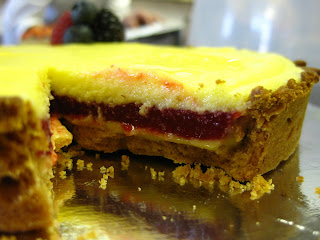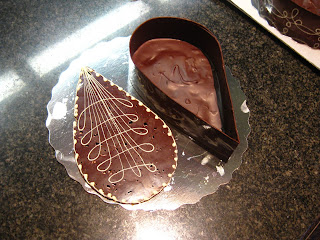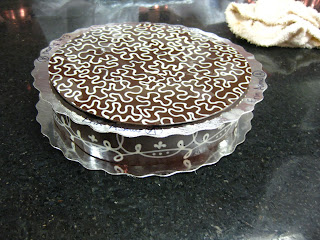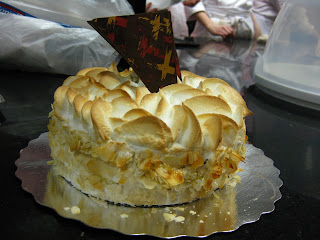Christmas Break had me rejuvenated
and ready to work. I was a little afraid
of Intermediate, as Chef Eric Jauoan really intimidated me, and I had heard
stories of him making students cry.
Nonetheless, I was so ready for Intermediate Pastry to begin.
We had orientation on a
Friday (January 4th), so Chad and I were back in town and all
settled on Thursday. The orientation
wasn’t really that…it was more of an introductory class. So, we all showed up, in clean and pressed
uniforms, to see what Intermediate was going to be like.
 |
| Chef Eric sporting a big smile at Graduation |
I was wrong about the
Chef. He was only a little scary because
he rarely talked, but rather stared at us without a smile. I discovered that he rarely talks because he
much prefers to speak in French. He
smiles often, and is actually a little crazy, going on frequent tangents and
swearing in French during his demos. He
figured out early on which of us speak French, and in the practicals when we
speak, he speaks to me in French and I reply in English. It is nice that we have the opportunity to
each speak our language of preference without inconveniencing the other. We have been bonding over the fact that I am American, as he lived in the US for quite a few years, and he often jokes about how few Americans speak French.
Leçon 1
Our first Intermediate
class consisted of tarts. Three tarts:
Tarte Fraise-Cassis (strawberry black currant tart), Tarte aux Poires au Flan
Caramel (pear and caramel tart), and Tarte Passion-Framboise (raspberry passion
fruit tart). The tarts themselves weren’t
very difficult, it was the requirement that was sure to catch us off
balance. We were required, for the first
time, to execute and finish two tarts in our 2.5-hour practical (the strawberry
and the passion fruit), rather than one.
The other difference: we were
using KitchenAids now!
 |
| Chef's Pear and Caramel Tart (with plated ones above) |
 |
| Chef's Strawberry and Currant tart (bottom) and Raspberry Passion Fruit tart (top) |
 |
| Chef's Raspberry Passion Fruit Tart |
The practical lived up
to my expectation: it was busy! I had
two completely different tarts to do in the time I was used to doing half of
that work. Using the KitchenAid was
different than what I was used to, and added another thing to have to think
about while working on something else. I
tried to hurry, but still ended the class not quite finished. My strawberry tart was short some berries on
the top, and my passion fruit tart should have had some passion fruit seeds in
the glaze. I also baked my pies in the
opposite tins. What an initiation into
Intermediate!
 |
| My Strawberry Tart (mission some berries, as you can see), Passion Fruit tart, and a passion fruit in the middle, so the Chef could show me what the inside of one looks like. |
 |
| The "Raspberry" in Passion Fruit Raspberry Tart comes from this disc of really tasty raspberry coulis in the center |
Leçon 2
For Lesson 2, we were
back in some familiar territory: Pâte à Choux.
We had some pretty extensive practice with the stuff in Basic, so this
lesson was more of a piping class. For
this Demo, the Chef showed us the Petits-Fours versions of piped pâte à choux
desserts: éclairs, salambo, swans, Paris-Brest, and religieuses. We were to make mini-versions of all of
these, small enough to eat in two bites or less.
 |
| Chef Eric's petits fours...more than we had to do in practical |
Most of the students
were pretty frazzled from the first practical, seeing as only about half of us
finished. We strove to work even faster
this time to be sure to complete our mission: six of each of the five types of
pastries, for 30 petits fours total. I
worked clean and organized, and I finished right down to the wire, but finished
completely. So far, it felt like every
day was exam day!
 |
| My Paris-Brest (left) and Swans (right). The swans' heads are a bit too large...but I can fix that next time |
 |
| My Salambo (left), coffee eclairs (top right), and chocolate religieuses (bottom right) |
 |
| My Paris-Brest and Swans |
 |
| My Religieuses were a little wobbly, but that seems normal |
Leçon 3
For Demo 3, Chef Eric
showed us two versions of the “Ambassadeur” cake; the traditional version, and
the Ambassadeur Exotique (Exotic Ambassador), which we were to recreate in the
practical. The traditional Ambassador
was a white cake with cream, buttercream, and macerated fruits, and the Exotic
Ambassador was a white cake with cream, fresh oranges and pineapples, and
meringue. The Chef made chocolate
triangles with transfer sheets to show us how they are used, but expressed his
dissent for them, and made it clear that this would be the only time we were to
even think of transfer sheets in the class.
 |
| The Chef piping some crazy designs on his traditional Ambassadeur |
 |
| Chef's Ambassadeur (Traditional) |
 |
| Chef's Ambassadeur Exotique |
The Practical went well
for my Ambassadeur Exotique! I finished
in plenty of time, though my meringue was a little over-whipped with the
machine. When it came time to temper chocolate
for my décor, I was successful, and the décor held up in the heat of the
room. Score!
 |
| My Ambassadeur Exotique |
Chocolate Piping Workshop
Before going any
further, the Chef gave us an entire three-hour workshop on chocolate
piping. At school, we pipe chocolate
with little bags folded from parchment paper (which we fold ourselves as we
need them), and we will be piping decorations on almost every cake from here on
out.
Chef Eric showed us a
few traditional borders and gave us a packet of suggestions, then set us free
to practice piping on paper. At the end
of the class, we were to pipe designs onto three fake cakes: two flipped cake
pans and a piece of parchment paper, cut to the size of an Opéra cake.
 |
| My piping |
 |
| My piping |
 |
| My piping |
Leçon 4
We were warned about
Lesson 4 during the chocolate piping workshop: it was the first time we would
pipe a chocolate border onto a real cake: The Fraisier. Fraisier is a delicious cake (my favorite so
far)! It is a vanilla cake with a very
tasty cream (called “mousseline cream”) and fresh strawberries. In the Demo, the Chef showed us three
versions of this same cake: the Traditional (the cake layered with the cream
and strawberries, iced with buttercream with fresh strawberries fanned on top),
Modern (the cake with exposed cream and fresh strawberries around the outside,
topped with marzipan and chocolate piping, a marzipan rose, and one fresh
strawberry on top), and a plated version of the modern one.
 |
| Chef's Fraisiers: Modern (bottom), Traditional (middle), and Plated (top) |
 |
| The inside of a slice of Chef Eric's Fraisier...so tasty! |
In the practical, we
were to make one full-sized modern Fraisier.
I hurried again, knowing that I would need to in order to let the cream
set in the fridge, and everything went well.
I am proud of my first chocolate piping on the cake. The Chef agreed that I did a nice job, but
reminded me that I still have a lot of practicing to do. He was, however, happy with my rose.
 |
| My Fraisier: the piping isn't too bad! |
 |
| Fresh strawberries and cream on the side |
 |
| Nice rose! |
Leçon 5
Lesson 5 began our
chocolate-intensive work in Intermediate, and it was the first time that our
tempering was absolutely crucial. Lesson
5 was the Chocolate Box. Chef Eric
showed us two boxes in the Demo, a teardrop-shaped and a round one. They are larger than I expected (the round
one is nine inches in diameter), and more fancy. The chef piped and embellished his box, but
he had enough time at the end of the class to show us a few other chocolate
décors.
 |
| Chef's Teardrop Box |
 |
| Chef's round box, side piping |
 |
| Chef's top. The wooden design is inlaid into the piece, and the other piping is on top |
 |
| This was my favorite of the other chocolate garnishes he showed us |
This practical was
really fun. I like working with
chocolate, and I think I want my future to include showpieces (maybe working
for a fancy hotel). We were given free
reign over the design of our box, and I was excited. I decided to pipe a white chocolate design on
the sides and the top, and finish the box with dark chocolate. My tempering went well, but it took longer
than I expected it to. I finished on
time, but only barely. My box stayed at
the school, along with all of the others.
On Wednesday, the Filled Bonbons lesson, I will make a bunch of
beautiful chocolates, fill my box with them, and take it home. I can’t wait!
 |
| Top of my box. This white chocolate is inside of the dark chocolate, making the piece smooth |
 |
| My box: side piping |
 |
| My chocolate box! The silver cake board isn't part of it, it is merely there to keep the top from melting onto the bottom in the warm practical room. |







No comments:
Post a Comment